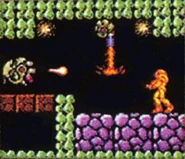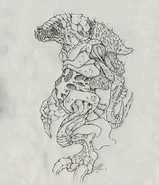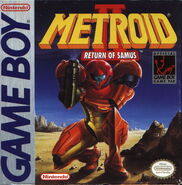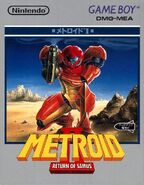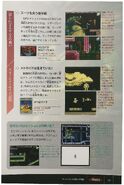(→Plot) |
|||
| (12 intermediate revisions by 5 users not shown) | |||
| Line 1: | Line 1: | ||
| + | {{DISPLAYTITLE:''Metroid II: Return of Samus''}} |
||
{{Featured article}}{{-}} |
{{Featured article}}{{-}} |
||
{{Reallife}}{{-}} |
{{Reallife}}{{-}} |
||
{{Infobox Game |
{{Infobox Game |
||
| − | | title = Metroid II: Return of Samus |
+ | | title = ''Metroid II: Return of Samus'' |
| image = [[File:Metroid II US boxart.jpg|280px|Box art for Metroid II]] |
| image = [[File:Metroid II US boxart.jpg|280px|Box art for Metroid II]] |
||
| caption = North American box art |
| caption = North American box art |
||
| Line 21: | Line 22: | ||
}} |
}} |
||
| − | {{nihongo|'''''Metroid II: Return of Samus'''''|メトロイドII RETURN OF SAMUS|Metoroido Tsū Ritān Obu Samusu}} is the sequel to ''[[Metroid]]'', the second game in the [[Metroid (series)|''Metroid'' series]], and the only one to be released for the [[Game Boy]]. It is about [[Samus Aran]]'s mission to exterminate the [[Metroid (species)|Metroids]] on their home planet, [[SR388]]. Although it is the second release in the series, [[Metroid timeline|chronologically]] it takes place after ''[[Metroid Prime: Federation Force]]'' and before ''[[Super Metroid]]''. |
+ | {{nihongo|'''''Metroid II: Return of Samus'''''|メトロイドII RETURN OF SAMUS|Metoroido Tsū Ritān Obu Samusu}} is the sequel to ''[[Metroid]]'', the second game in the [[Metroid (series)|''Metroid'' series]], and the only one to be released for the [[Game Boy]]. It is about [[Samus Aran]]'s [[SR-388 incident|mission]] to exterminate the [[Metroid (species)|Metroids]] on their home planet, [[SR388]]. Although it is the second release in the series, [[Metroid timeline|chronologically]] it takes place after ''[[Metroid Prime: Federation Force]]'' and before ''[[Super Metroid]]''. |
''[[Metroid: Samus Returns]]'', a 2.5D remake of the game for [[Nintendo 3DS]], was announced during the Nintendo Treehouse broadcast on June 13, 2017. It was released on September 15, 2017. |
''[[Metroid: Samus Returns]]'', a 2.5D remake of the game for [[Nintendo 3DS]], was announced during the Nintendo Treehouse broadcast on June 13, 2017. It was released on September 15, 2017. |
||
==Plot== |
==Plot== |
||
| − | [[File:Samus's Gunship - Metroid II.png|thumb|left|[[Samus Aran's |
+ | [[File:Samus's Gunship - Metroid II.png|thumb|left|[[Samus Aran's Gunship]] as seen in ''Metroid II: Return of Samus.'']] |
| − | After the events of ''[[Metroid: Zero Mission]]'' and the [[Metroid Prime series|''Metroid Prime'' series]], where [[Samus Aran]] put a stop to numerous [[Space Pirate]] operations intending to use the newly discovered [[Metroid (species)|Metroids]] for evil purposes and defeated [[Dark Samus|a being]] born from [[Metroid Prime (creature)|a heavily mutated Metroid]], the [[Galactic Federation]] called its members to an urgent conference. After serious consideration, they reached a conclusion: the extremely dangerous Metroids must be rendered extinct, which would ensure the creatures would never again give rise to chaos similar to those seen in the past. The Federation first sent a research team to the Metroid homeworld, [[SR388]], to investigate the presence of any remaining Metroids. When contact with the research team's base and ship were lost, two additional teams were sent, first a search and rescue party then a [[Galactic Federation Special Squadron]], but one after the other, they too were not heard from again. |
+ | After the events of ''[[Metroid: Zero Mission]]'' and the [[Metroid Prime (series)|''Metroid Prime'' series]], where [[Samus Aran]] put a stop to numerous [[Space Pirate]] operations intending to use the newly discovered [[Metroid (species)|Metroids]] for evil purposes and defeated [[Dark Samus|a being]] born from [[Metroid Prime (creature)|a heavily mutated Metroid]], the [[Galactic Federation]] called its members to an urgent conference. After serious consideration, they reached a conclusion: the extremely dangerous Metroids must be rendered extinct, which would ensure the creatures would never again give rise to chaos similar to those seen in the past. The Federation first sent a research team to the Metroid homeworld, [[SR388]], to investigate the presence of any remaining Metroids. When contact with the research team's base and ship were lost, two additional teams were sent, first a search and rescue party then a [[Galactic Federation Special Squadron]], but one after the other, they too were not heard from again. |
| − | Realizing the threat that the species still pose, the Galactic Federation sends [[Samus Aran]] on a mission to land on [[SR388]] and destroy all Metroid organisms. With her experience in past events with Metroids, the Galactic Federation is certain she will succeed. |
+ | Realizing the threat that the species still pose, the Galactic Federation sends [[Samus Aran]] on a [[SR-388 incident|mission]] to land on [[SR388]] and destroy all Metroid organisms. With her experience in past events with Metroids, the Galactic Federation is certain she will succeed. |
| − | Arriving, Samus lands her [[Samus Aran's |
+ | Arriving, Samus lands her [[Samus Aran's Gunship|gunship]] near the only entrance to the planet's underground areas. She exits her ship and begins the difficult trek through the planet's dark network of caves and ruins.<ref name="Story">{{cite book | year=1991 | publisher=Nintendo of America, Inc. | title=Metroid II: Return of Samus instruction manual | pages=3–6 }}</ref> |
| − | [[File: |
+ | [[File:Phase 9 Queen.gif|thumb|The [[Queen Metroid]] as seen in ''Metroid II: Return of Samus''.]] |
| − | One by one, |
+ | One by one, Samus hunts down and destroys each Metroid on the planet. As she does so, she takes note of the steady mutation that each goes through. She discovers Metroids in stages of growth from the small jellyfish-like state into massive, hovering lizard-like beasts. |
| − | As Samus travels deeper and deeper, the planet rumbles at intervals and the acid drains, revealing a massive complex of [[Chozo]] ruins. Finally, after several harrowing battles with massive [[Omega Metroid]]s, she uncovers a small ruined laboratory-like structure with mature [[Metroid larva]]e floating in the breeze. With their destruction, only one Metroid remains |
+ | As Samus travels deeper and deeper, the planet rumbles at intervals and the acid drains, revealing a massive complex of [[Chozo]] ruins. Finally, after several harrowing battles with massive [[Omega Metroid]]s, she uncovers a small ruined laboratory-like structure with mature [[Metroid larva]]e floating in the breeze. With their destruction, only one Metroid remains: the massive and deadly [[Queen Metroid]]. Samus fights a final battle before finally defeating the monster, and the [[Queen's nest]] rumbles as the Queen crumbles to dust. |
| − | Returning to her gunship, Samus comes across a [[Metroid Egg |
+ | Returning to her gunship, Samus comes across a [[Metroid Egg]]. The egg hatches and before her eyes a small [[Baby|Metroid hatchling]] floats out of the broken shell and begins to chirp at her. The Metroid, upon seeing Samus, believes her to be its mother. Samus, despite being ordered to exterminate the Metroids, spares its life. The two continue towards the surface, and the Metroid hatchling helps Samus escape the caverns by eating otherwise indestructible [[crystals]]. Samus and the young Metroid board the gunship, ending the game. |
| − | On board the |
+ | On board the gunship, Samus places the Metroid in [[Metroid capsule|a container]] so that it cannot cause any harm to the ship. Noting the immense scientific opportunity that the captured hatchling poses, she departs [[SR388]] and heads to [[Ceres Space Colony]] to deliver her groundbreaking find — a domesticated, baby Metroid. |
The events of ''[[Super Metroid]]'' follow almost immediately afterward. |
The events of ''[[Super Metroid]]'' follow almost immediately afterward. |
||
| Line 62: | Line 63: | ||
*[[Area 5|Phase 7]]: Contains 4 Gamma Metroids and 3 [[Zeta Metroid]]s. |
*[[Area 5|Phase 7]]: Contains 4 Gamma Metroids and 3 [[Zeta Metroid]]s. |
||
*[[Phase 8 (Disambiguation)|Phase 8]]: Contains 1 Alpha Metroid and 4 [[Omega Metroid|Omega Metroids]]. |
*[[Phase 8 (Disambiguation)|Phase 8]]: Contains 1 Alpha Metroid and 4 [[Omega Metroid|Omega Metroids]]. |
||
| − | *[[Area 8|Phase 9]]: Contains 8 [[ |
+ | *[[Area 8|Phase 9]]: Contains 8 [[Metroid larva]]e, the [[Queen Metroid]] final boss, and a [[Metroid Egg]] that hatches, giving birth to the [[baby]]. |
===Items and abilities=== |
===Items and abilities=== |
||
''Main article: [[List of items in Metroid II: Return of Samus]]'' |
''Main article: [[List of items in Metroid II: Return of Samus]]'' |
||
| − | Rather than being the first items she finds as in most ''Metroid'' games, Samus begins her mission with the [[Morph Ball|Morphing Ball]], the [[Long Beam]], and 30 [[Missile]]s. The [[Ice Beam]] and [[Wave Beam]] return as upgrades, as well as the [[Bomb]]s, the [[Varia Suit]] (known in the game as "Varia" and in the manual as the "Barrier Suit"<ref name="Varia">{{cite book | year=1991 | publisher=Nintendo of America, Inc. | title=Metroid II: Return of Samus instruction manual | pages=14 }}</ref>), the [[High Jump Boots]], and the [[Screw Attack]]. ''Metroid II'' also introduces new items into the series, most of which have been in almost every game since. The game features two new weapons: the tri-splitting [[Spazer Beam|Spazer Laser Beam]]<ref>(1991) ''Metroid II: Return of Samus - Instruction Booklet'', DMG-ME-USA-2. Nintendo of America, Inc., p. 22</ref> (identified in-game as the "Spazer"), and the |
+ | Rather than being the first items she finds as in most ''Metroid'' games, Samus begins her mission with the [[Morph Ball|Morphing Ball]], the [[Long Beam]], and 30 [[Missile]]s. The [[Ice Beam]] and [[Wave Beam]] return as upgrades, as well as the [[Bomb]]s, the [[Varia Suit]] (known in the game as "Varia" and in the manual as the "Barrier Suit"<ref name="Varia">{{cite book | year=1991 | publisher=Nintendo of America, Inc. | title=Metroid II: Return of Samus instruction manual | pages=14 }}</ref>), the [[High Jump Boots]], and the [[Screw Attack]]. ''Metroid II'' also introduces new items into the series, most of which have been in almost every game since. The game features two new weapons: the tri-splitting [[Spazer Beam|Spazer Laser Beam]]<ref>(1991) ''Metroid II: Return of Samus - Instruction Booklet'', DMG-ME-USA-2. Nintendo of America, Inc., p. 22</ref> (identified in-game as the "Spazer"), and the powerful [[Plasma Beam]] that pierces through enemies. As in ''Metroid'', only one beam can be equipped at a time, though Samus can switch between them by collecting the beam she wants to use again, which is easiest to do in [[Area 5|Phase 7]], as it contains all available Beams. |
| − | The [[Space Jump]] also |
+ | The [[Space Jump]] also makes its debut in this game, which allows Samus to spin-jump repeatedly in the air, allowing her to access otherwise unreachable areas. The [[Screw Attack]] can be used in conjunction with the Space Jump to shred through almost everything. |
New upgrades were given to the [[Morph Ball]]. The [[Spider Ball]] made its debut in ''Metroid II'' and would later appear again in ''[[Metroid Prime]]'' and subsequent sequels. The Spider Ball allowed Samus to climb any wall or ceiling, unlike its ''Prime'' counterpart which only allowed Samus to ride along [[Spider Ball Track|special "magnetic" rails]]. The [[Spring Ball]] was also introduced, which gives Samus the ability to jump while in Morph Ball form. |
New upgrades were given to the [[Morph Ball]]. The [[Spider Ball]] made its debut in ''Metroid II'' and would later appear again in ''[[Metroid Prime]]'' and subsequent sequels. The Spider Ball allowed Samus to climb any wall or ceiling, unlike its ''Prime'' counterpart which only allowed Samus to ride along [[Spider Ball Track|special "magnetic" rails]]. The [[Spring Ball]] was also introduced, which gives Samus the ability to jump while in Morph Ball form. |
||
===Metroid life cycle=== |
===Metroid life cycle=== |
||
| − | {{main|Metroid_(Species)#Life_Cycle_on_SR388 |
+ | {{main|Metroid_(Species)#Life_Cycle_on_SR388}}[[File:Metroid_Life_Cycle.PNG|thumb|The [[Metroid (species)|Metroid]] life cycle as seen in the 1991 game. The name "Mature" is no longer used to describe the second form.]] |
''Metroid II: Return of Samus'', ''[[Metroid: Samus Returns]]'' and ''[[Metroid Fusion]]'' are the only ''Metroid'' games that show the assumed natural evolution of the Metroids, but the former two titles are the only ones where Samus battles them. The stages of a Metroid is in the following order (excluding [[Metroid Egg]]s): |
''Metroid II: Return of Samus'', ''[[Metroid: Samus Returns]]'' and ''[[Metroid Fusion]]'' are the only ''Metroid'' games that show the assumed natural evolution of the Metroids, but the former two titles are the only ones where Samus battles them. The stages of a Metroid is in the following order (excluding [[Metroid Egg]]s): |
||
#[[Infant Metroid]] (not battled) |
#[[Infant Metroid]] (not battled) |
||
| Line 93: | Line 94: | ||
''Metroid II'' is more linear than most games in the franchise, as most areas are blocked off until a certain number of [[Metroids]] are killed. It was well-received nonetheless — ''[[Nintendo Power]]'' gave it a 4.5/5 and most gaming magazines and websites such as IGN<ref>http://m.ign.com/articles/2011/11/26/metroid-ii-return-of-samus-review</ref> and Nintendo Life<ref>http://www.nintendolife.com/reviews/2011/11/metroid_ii_return_of_samus_3dsvc</ref> have a similar opinion. |
''Metroid II'' is more linear than most games in the franchise, as most areas are blocked off until a certain number of [[Metroids]] are killed. It was well-received nonetheless — ''[[Nintendo Power]]'' gave it a 4.5/5 and most gaming magazines and websites such as IGN<ref>http://m.ign.com/articles/2011/11/26/metroid-ii-return-of-samus-review</ref> and Nintendo Life<ref>http://www.nintendolife.com/reviews/2011/11/metroid_ii_return_of_samus_3dsvc</ref> have a similar opinion. |
||
| − | In spite of this, some critics and gamers consider it among the weakest titles of the series, compared to ''[[Super Metroid]]'' or ''[[Metroid Fusion]]''. The main criticisms were directed at the repetitive 39 Metroid boss battles and similar-looking areas combined with the lack of an in-game [[map]] making navigation difficult. Much of the music was also deemed as forgettable and/or unmelodic, except for the [[Surface |
+ | In spite of this, some critics and gamers consider it among the weakest titles of the series, compared to ''[[Super Metroid]]'' or ''[[Metroid Fusion]]''. The main criticisms were directed at the repetitive 39 Metroid boss battles and similar-looking areas combined with the lack of an in-game [[map]] making navigation difficult. Much of the music was also deemed as forgettable and/or unmelodic, except for the [[Surface (theme)|Surface]] theme. |
Prior to the release of ''Metroid: Samus Returns'', ''Metroid II'' was often viewed merely as a connection between the first and third released titles and as an expansion on Metroid morphology. Still, it was later repackaged in a gold colored box along with the official [[Player's Choice]] emblem, showing it was a commercial success. |
Prior to the release of ''Metroid: Samus Returns'', ''Metroid II'' was often viewed merely as a connection between the first and third released titles and as an expansion on Metroid morphology. Still, it was later repackaged in a gold colored box along with the official [[Player's Choice]] emblem, showing it was a commercial success. |
||
| Line 143: | Line 144: | ||
Metroid II JP boxart.jpg|Japanese box art |
Metroid II JP boxart.jpg|Japanese box art |
||
350 2.jpg|PAL [[Game Boy]] Pocket bundle with ''Metroid II'' and ''Wave Race'' |
350 2.jpg|PAL [[Game Boy]] Pocket bundle with ''Metroid II'' and ''Wave Race'' |
||
| − | Tony |
+ | Tony in Nintendo Land card.jpg|Kellogg's Frosties Nintendo Collector Card No. 6 of 24 (front). |
| + | Tony the Tiger Samus card.png|The back of the card. The answer to the question of whether Samus is female is spoiled in the description. |
||
Metroid II 3DS Virtual Console icon.JPG|[[Nintendo 3DS|3DS]] Virtual Console HOME Menu icon |
Metroid II 3DS Virtual Console icon.JPG|[[Nintendo 3DS|3DS]] Virtual Console HOME Menu icon |
||
| − | + | JP Other M Guide 169.jpg|''[[Nintendo Official Guidebook for Metroid Other M]]'', page 169 |
|
</gallery> |
</gallery> |
||
| Line 155: | Line 157: | ||
*''[[Another Metroid 2 Remake]]'' |
*''[[Another Metroid 2 Remake]]'' |
||
*''[[Metroid: Samus Returns]]'' |
*''[[Metroid: Samus Returns]]'' |
||
| + | *[[Nintendo eShop - Metroid 2: Return of Samus Trailer]] |
||
==References== |
==References== |
||
Revision as of 04:40, 25 October 2019
| This is a featured article. |
| This article is written from the Real Life point of view |
Metroid II: Return of Samus (メトロイドII RETURN OF SAMUS Metoroido Tsū Ritān Obu Samusu) is the sequel to Metroid, the second game in the Metroid series, and the only one to be released for the Game Boy. It is about Samus Aran's mission to exterminate the Metroids on their home planet, SR388. Although it is the second release in the series, chronologically it takes place after Metroid Prime: Federation Force and before Super Metroid.
Metroid: Samus Returns, a 2.5D remake of the game for Nintendo 3DS, was announced during the Nintendo Treehouse broadcast on June 13, 2017. It was released on September 15, 2017.
Plot
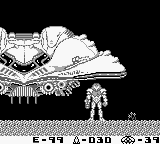
Samus Aran's Gunship as seen in Metroid II: Return of Samus.
After the events of Metroid: Zero Mission and the Metroid Prime series, where Samus Aran put a stop to numerous Space Pirate operations intending to use the newly discovered Metroids for evil purposes and defeated a being born from a heavily mutated Metroid, the Galactic Federation called its members to an urgent conference. After serious consideration, they reached a conclusion: the extremely dangerous Metroids must be rendered extinct, which would ensure the creatures would never again give rise to chaos similar to those seen in the past. The Federation first sent a research team to the Metroid homeworld, SR388, to investigate the presence of any remaining Metroids. When contact with the research team's base and ship were lost, two additional teams were sent, first a search and rescue party then a Galactic Federation Special Squadron, but one after the other, they too were not heard from again.
Realizing the threat that the species still pose, the Galactic Federation sends Samus Aran on a mission to land on SR388 and destroy all Metroid organisms. With her experience in past events with Metroids, the Galactic Federation is certain she will succeed.
Arriving, Samus lands her gunship near the only entrance to the planet's underground areas. She exits her ship and begins the difficult trek through the planet's dark network of caves and ruins.[1]
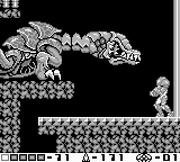
The Queen Metroid as seen in Metroid II: Return of Samus.
One by one, Samus hunts down and destroys each Metroid on the planet. As she does so, she takes note of the steady mutation that each goes through. She discovers Metroids in stages of growth from the small jellyfish-like state into massive, hovering lizard-like beasts.
As Samus travels deeper and deeper, the planet rumbles at intervals and the acid drains, revealing a massive complex of Chozo ruins. Finally, after several harrowing battles with massive Omega Metroids, she uncovers a small ruined laboratory-like structure with mature Metroid larvae floating in the breeze. With their destruction, only one Metroid remains: the massive and deadly Queen Metroid. Samus fights a final battle before finally defeating the monster, and the Queen's nest rumbles as the Queen crumbles to dust.
Returning to her gunship, Samus comes across a Metroid Egg. The egg hatches and before her eyes a small Metroid hatchling floats out of the broken shell and begins to chirp at her. The Metroid, upon seeing Samus, believes her to be its mother. Samus, despite being ordered to exterminate the Metroids, spares its life. The two continue towards the surface, and the Metroid hatchling helps Samus escape the caverns by eating otherwise indestructible crystals. Samus and the young Metroid board the gunship, ending the game.
On board the gunship, Samus places the Metroid in a container so that it cannot cause any harm to the ship. Noting the immense scientific opportunity that the captured hatchling poses, she departs SR388 and heads to Ceres Space Colony to deliver her groundbreaking find — a domesticated, baby Metroid.
The events of Super Metroid follow almost immediately afterward.
Gameplay
Gameplay is similar to other 2D Metroid games. However, Metroid II is more linear in the sense that advancement through the levels is not strictly controlled by item acquisition as in the other games, but by killing a certain number of Metroids in the area. Once they are destroyed, an earthquake occurs and SR388's corrosive liquid drains to a lower level, allowing Samus to travel deeper through its maze-like tunnels. Metroid Husks throughout the planet indicate that Samus is in close proximity to a Metroid.
Like Metroid, Metroid II contains no in-game map. Where it differs, however, is the map being made of multiple, discontinuous sections that produce a "scene fade" effect when crossing (similar to riding elevators in other games). These sections do not fit together in a flat, 2-D pattern, making the 2-D space of the map "twisted". It is the first game of the Metroid series to do so. Metroid Fusion and Metroid: Zero Mission later use this method, even while retaining an in-game map. Also unique to the game is the Metroid Detector, which displays the number of Metroids left on the planet. It is also the first in the series to utilize Save Stations, located in various points around the planet.
Metroid II is also the first Metroid game in which Samus can kneel or shoot downward in midair. These actions were not possible in the original Metroid.
Miscellaneous information
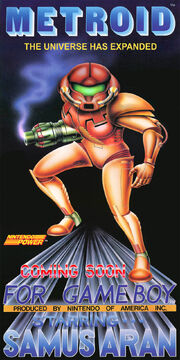
A commercial poster for Metroid II: Return of Samus from Nintendo Power.
Areas
Note: These area names come from the official guide in Nintendo Power. The areas are named Surface and Area 1 through Area 8 (respectively) in the official remake, Metroid: Samus Returns. Also note that Phases 5 and 6 were combined into Area 4, and Phase 8 was split into Area 6 and Area 7.
- Phase 1: Contains 1 Alpha Metroid.
- Phase 2: Contains 4 Alpha Metroids.
- Phase 3: Contains 6 Alpha Metroids, 2 Gamma Metroids and the optional boss Arachnus.
- Phase 4: Contains 2 Alpha Metroids and 8 Gamma Metroids.
- Phase 5: Contains 1 Gamma Metroid.
- Phase 6: Contains 1 Alpha Metroid and 1 Gamma Metroid.
- Phase 7: Contains 4 Gamma Metroids and 3 Zeta Metroids.
- Phase 8: Contains 1 Alpha Metroid and 4 Omega Metroids.
- Phase 9: Contains 8 Metroid larvae, the Queen Metroid final boss, and a Metroid Egg that hatches, giving birth to the baby.
Items and abilities
Main article: List of items in Metroid II: Return of Samus
Rather than being the first items she finds as in most Metroid games, Samus begins her mission with the Morphing Ball, the Long Beam, and 30 Missiles. The Ice Beam and Wave Beam return as upgrades, as well as the Bombs, the Varia Suit (known in the game as "Varia" and in the manual as the "Barrier Suit"[2]), the High Jump Boots, and the Screw Attack. Metroid II also introduces new items into the series, most of which have been in almost every game since. The game features two new weapons: the tri-splitting Spazer Laser Beam[3] (identified in-game as the "Spazer"), and the powerful Plasma Beam that pierces through enemies. As in Metroid, only one beam can be equipped at a time, though Samus can switch between them by collecting the beam she wants to use again, which is easiest to do in Phase 7, as it contains all available Beams.
The Space Jump also makes its debut in this game, which allows Samus to spin-jump repeatedly in the air, allowing her to access otherwise unreachable areas. The Screw Attack can be used in conjunction with the Space Jump to shred through almost everything.
New upgrades were given to the Morph Ball. The Spider Ball made its debut in Metroid II and would later appear again in Metroid Prime and subsequent sequels. The Spider Ball allowed Samus to climb any wall or ceiling, unlike its Prime counterpart which only allowed Samus to ride along special "magnetic" rails. The Spring Ball was also introduced, which gives Samus the ability to jump while in Morph Ball form.
Metroid life cycle
The Metroid life cycle as seen in the 1991 game. The name "Mature" is no longer used to describe the second form.
Metroid II: Return of Samus, Metroid: Samus Returns and Metroid Fusion are the only Metroid games that show the assumed natural evolution of the Metroids, but the former two titles are the only ones where Samus battles them. The stages of a Metroid is in the following order (excluding Metroid Eggs):
The more powerful Metroids are found further into the game, with the Queen Metroid being the final boss.
Development
Metroid II marked a "new high point" for handheld game consoles, with graphics that were almost as good as the 8-bit graphics in games for the Nintendo Entertainment System. The game was the first in the series to feature a battery backup to allow players to continue their games from a previously saved point[4]. Metroid II was designed by Nintendo R&D1 and produced by Gunpei Yokoi; they both also worked on the previous Metroid game. Metroid II was released as the second game of the series, but it is chronologically the sixth in the overall story. The game features enhancements from its predecessor that include easier controls which allow Samus to crouch while firing at the same time, and jump while shooting straight down to attack anything below her.[5]
The Game Boy's black and white graphics limited the detail in each area of the game and forced changes to Samus' appearance, which would later be used for the rest of the series. In the original Metroid on the NES, Samus' suit would change color to show the difference between Samus's Power and Varia Suits. However, without color on the Game Boy, the two suits appeared the same. This forced the developers to create a visual indicator for players to determine which suit Samus was wearing. They updated her Varia Suit, adding round, bulky metal shoulders that have been a part of the suit in every game in the series since then. Even though the game cartridge for Metroid II has six times less memory than its predecessor on the Nintendo Entertainment System, the game allowed players to save their progress for the first time in the series. To save the game, players would step on save modules, which have appeared in every Metroid game since. Metroid II and Metroid Fusion are the only games in the entire series to show the natural life cycle of the Metroids. Because of the Game Boy's small screen, the developers made Samus's model bigger compared to her surroundings, to give more detail in her appearance using limited graphics capabilities. While improving Samus's design, the changes also made the environments feel "cramped".[5]
Reception
Metroid II is more linear than most games in the franchise, as most areas are blocked off until a certain number of Metroids are killed. It was well-received nonetheless — Nintendo Power gave it a 4.5/5 and most gaming magazines and websites such as IGN[6] and Nintendo Life[7] have a similar opinion.
In spite of this, some critics and gamers consider it among the weakest titles of the series, compared to Super Metroid or Metroid Fusion. The main criticisms were directed at the repetitive 39 Metroid boss battles and similar-looking areas combined with the lack of an in-game map making navigation difficult. Much of the music was also deemed as forgettable and/or unmelodic, except for the Surface theme.
Prior to the release of Metroid: Samus Returns, Metroid II was often viewed merely as a connection between the first and third released titles and as an expansion on Metroid morphology. Still, it was later repackaged in a gold colored box along with the official Player's Choice emblem, showing it was a commercial success.
Color version and remakes
Dan Owsen of Nintendo claimed that the color-palette needs of Metroid II were taken into account in the design of the Game Boy Color hardware, but was not aware of plans to release a colorized version of the game.[8] A DX Metroid II never surfaced.
Like all original Game Boy games, the Metroid II cartridge is compatible with the Super Game Boy accessory for the SNES, manually remapping the color scheme to a maximum of four different colors. Additionally, the Game Boy Player accessory for the Nintendo GameCube automatically colorizes the game, but not true full color, as it is still limited to the same colorization techniques of the GBC and GBA.
According to Retro Studios artist, Ben Sprout in 2009:
| “ | I've always thought it’d be awesome to remake Metroid 2. A group of us at Retro even discussed doing it as a side project at one point. Nothing ever came of it, though I still think it’d be fun to remake it as a 3D sidescroller. | „ |
On August 6, 2016, a fan remake of Metroid II, called Another Metroid 2 Remake, was released for free online. The game, which was unsanctioned by Nintendo, was quickly pulled offline after a DMCA takedown request, but is still available through torrents. The following year, Metroid: Samus Returns, an official remake was revealed at E3 2017 and was released on September 15, 2017. It is believed that Nintendo took down AM2R to prevent unofficial competition at launch.
Danny Richardson created concept art of an Omega Metroid for Metroid Prime, although there is no evidence that the creature was planned to be featured in the game.
Virtual Console
Metroid II was re-released for Nintendo 3DS Virtual Console. Rather than include a new color palette, it instead features the option to turn the screen from black and white to green monochromes, which emulates the Game Boy's monochrome display. In addition to the in-game save feature, it also has a "Restore Point" function, which allows players to save the state of their game.
A download code for Metroid II on the Nintendo eShop is included in the Legacy Edition of its remake, Metroid: Samus Returns.
An earlier digital release was considered alongside other Game Boy titles in a 2006 patent for a Nintendo branded cellular phone.[9]
Trivia
- Oddly enough, Samus' mission on SR388 featured only a total of 48 or 51 Metroids in Metroid II: Return of Samus and Metroid: Samus Returns respectively, despite the planet being the species' homeworld.
- Metroid II: Return of Samus lacks many staple Metroid elements. It does not have a Countdown at any point in the game, including the sequence after its final boss battle. Metroid II is also the only game in the series not to feature any Elevators as well as neither Ridley nor Space Pirates.
- Metroid II is also the only non-spinoff game to not feature the Title theme, the Silence theme, or the Samus Aran's Appearance Fanfare of the first game in any capacity. All three of these songs were included in Samus Returns.
- Until Metroid: Samus Returns, Metroid II had never had any of its own music remixed in a future game or feature remixed music (apart from the item acquisition fanfare).
- Until the Nintendo 3DS, Metroid II was the only Metroid game not playable on a current-gen console in some form, excluding emulators. The second most recent console that was capable of playing it was the Game Boy Advance SP. Metroid II was released for the 3DS Virtual Console on September 28, 2011 in Japan, and November 24th of the same year internationally.
- With a total of 39 Metroid boss battles and Arachnus, Metroid II: Return of Samus used to have the highest number of boss battles of any game in the Metroid series. It was later eclipsed by its remake, Metroid: Samus Returns, which adds 1 Metroid, the Diggernaut and Proteus Ridley.
- The lack of color in Metroid II had long-term effects on Samus' appearance. In Metroid, the Varia Suit was a different color from the normal Power Suit, but the same shape. In Metroid II, the Varia Suit had to have a different shape to distinguish the Suits because there was no color. Thus, the Varia Suit gained the extra armor plating and bulky, round shoulder pads that have become its most recognizable traits. In addition, rather than Samus' Arm Cannon and Visor changing color when Missiles were activated or deactivated, the end of the Arm Cannon tip moved outward and back to show that the "missile hatch" was open. These graphical changes have been used in all Metroid games since Metroid II, including the remake of the first game, Metroid: Zero Mission. With regards to the Power Suit's appearance, the official in-universe explanation is that the Varia Suit with bulky shoulder pads is a Legendary Power Suit, which Samus receives after losing her original Power Suit when her Gunship crashes.
- The Super Game Boy Player's Guide has suggested color palettes to use throughout the game if playing with a Super Game Boy. It was given out with issues of Nintendo Power around the time of the Super Game Boy's release.
- Certain aspects of this game are similar to the movie Aliens. Both involve the female protagonists (Ellen Ripley/Samus) travelling to the homeworld of the alien specimens (LV-426/SR388) to exterminate them, both depict a final battle with the queen of the creatures (Queen Alien/Queen Metroid), and both depict the female protagonists bonding with a child (in Ripley's case, it is a colonist nicknamed "Newt" while in Samus' case it is the Baby).
- The narrator in the US TV commercial for Return of Samus[10][11][12] erroneously states that one Metroid survived "the first Metroid adventure" and is rapidly multiplying. In actuality, Samus eradicated a completely different strain of Metroids on Zebes while leaving the ones on SR388 untouched. Additionally, Metroids do not multiply unless they are exposed to Beta-Rays; they reproduce exclusively through a Queen Metroid laying eggs.
- The instruction manual of the game notably has several spelling mistakes in the descriptions for the enemies Halzyn and Moheek.
- Additionally, the instruction manual states that Samus has an Infrared Ray Scope that allows her to see in the dark. This is untrue, however, as there are many occasions where Samus cannot see in the dark, including a pitch-black area in the Chozo ruins of Phase 7. It is possible that it was a scrapped item.
Gallery
- For concept art, see Metroid II: Return of Samus image gallery.
See also
- List of creatures in Metroid II: Return of Samus
- List of bosses in Metroid II: Return of Samus
- List of items in Metroid II: Return of Samus
- Metroid II: Return of Samus/Staff
- Another Metroid 2 Remake
- Metroid: Samus Returns
- Nintendo eShop - Metroid 2: Return of Samus Trailer
References
- ^ (1991) Metroid II: Return of Samus instruction manual. Nintendo of America, Inc., 3–6.
- ^ (1991) Metroid II: Return of Samus instruction manual. Nintendo of America, Inc., 14.
- ^ (1991) Metroid II: Return of Samus - Instruction Booklet, DMG-ME-USA-2. Nintendo of America, Inc., p. 22
- ^ Kent, Steven L. (1994-05-05). Inside Moves. The Seattle Times. Retrieved on 2009-02-19.
- ^ a b The Metroid Retrospective – Part 1. GameTrailers (2007-07-25). Retrieved on 2009-02-19.
- ^ http://m.ign.com/articles/2011/11/26/metroid-ii-return-of-samus-review
- ^ http://www.nintendolife.com/reviews/2011/11/metroid_ii_return_of_samus_3dsvc
- ^ The MDb Interviews Dan Owsen. www.metroid-database.com. Retrieved on 2006-06-29.
- ^ http://www.google.com/patents?id=GBh4AAAAEBAJ&printsec=abstract&zoom=4#v=onepage&q&f=false
- ^ Nintendo Gameboy - Metroid II: Return of Samus (US) (1991) (30 July 2006). Retrieved on May 13, 2018.
- ^ Metroid II Commercial (18 July 2006). Retrieved on April 12 2018.
- ^ Metroid II US Commercial (April 3, 2008). Retrieved on June 9, 2018.


